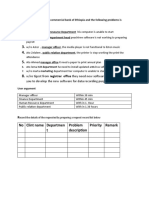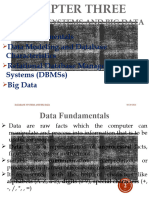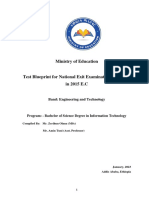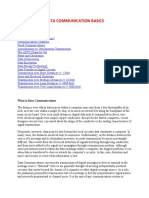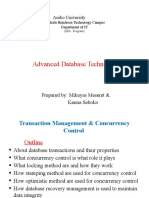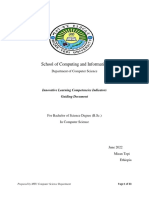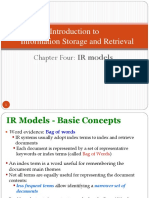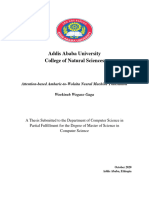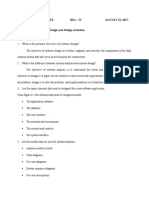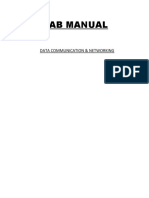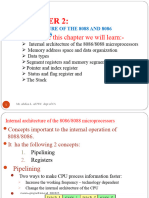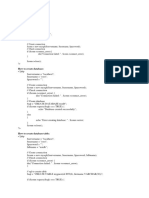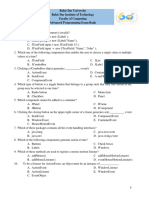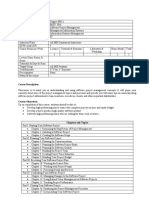0 ratings0% found this document useful (0 votes)
223 views50 pagesAll Course Title For Cs
computer science course
Uploaded by
Eshetu GeletuCopyright
© © All Rights Reserved
We take content rights seriously. If you suspect this is your content, claim it here.
Available Formats
Download as PDF or read online on Scribd
0 ratings0% found this document useful (0 votes)
223 views50 pagesAll Course Title For Cs
computer science course
Uploaded by
Eshetu GeletuCopyright
© © All Rights Reserved
We take content rights seriously. If you suspect this is your content, claim it here.
Available Formats
Download as PDF or read online on Scribd
You are on page 1/ 50
1. Course Information
Introduction to Emerging Technologies
Conrse Code: Em Te 1012
Course title: Introduction to emerging technologies
Credit hours: 3 hrs Contact hrs: 5 hrs (3hr lecture * 2hr tutorial)
Prerequisite(s): None Prior knowledge
Academic Year: Semester: II Year: |
Department
College/Faculty/Institute:
Program: — Undergraduate Enrollment: Regular
Course Status: Common
Instructor(s):
1) Instructor(s): Address: Block No. _Ream No.
2) Tutor: Address: Block No. __ Room No.
Others (if any):
Course Description
This course will enable students to explore current breakthrough technologies in the areas of Anificial
Intelligence, Intemet of Things and Augmented Reality that have emerged over the past few years. Besides
helping learners become literate in emerging technologies, the course will prepare them to use technology in
their respective professional preparations.
Objective of the course
Up on the completion of this course students will be able to:
> Identify different emerging technologies
> Differentiate different emerging technologies
> Select appropriate technology and tools for a given task
> Identify necessary inputs for application of emerging technologies
This Curriculum is applicable for 2012 EXC and Above Entry Students Page 235
Week 3 - 4
Week 1-2
| 23. Basic concepts of Big data
syllabus Components Course Contents,
‘anient & sub-contents
| Chapter: Ttvodvetion to Emerging
| Technotosies
| 1.1 Evolution of Technologies W
| 1.1.1 introduction to Industrial revolution
aR)
1.1.2 Historical Background (IR 1,0, 1R
2.0,1R 3.0)
1.1.3 Fourth Industrial Revolution (IR
4.0)
1.2 Role of Data for Emerging 9
Technologies
Methods & strategies, and learning outcomes
Methods &
] Students Task
Strategies
* Note-taking, Listen and take notes
* Brainstorming,
Answer questions
© Reading Read
© Individual work + Doing class works and
* Group home works,
discussion
Reflects
* Reflections
* Gapped Lecture
| Outcomes:
chapter stud
eee will be able to
istening Attend the lesson» Develop
knowledge of IR
Identifies
programmable
device
Develop the
with machine
knowledge how
‘computer interact
Ye =e |
| at the end of |
om
Develop general
| 1.3 Enabling devices and network eee about |
| Programmable devices) —o
| \.4 Human to Machine Interaction #
1.5 Future Trends in Emerging ~~
| Technologies
t ‘Chapter 2: Introduction to Data Science * Listening © Attend the lesson * Develop the
| 2.1. Overview for Data Science * Note-taking, * Listen and take short Knowledge of
| Definition of data and * Brainstorming notes, | data science
o information ‘* Gapped Lecture} * Asking and answering |* Identify the
| a12 Datatypes and * Group questions, various data value
| representation discussion * Doing class works chain
| 2.2,Data Value Chain * Class work and home works, |» Know how about
2.2.1, Data Acquisition * Tutorials + Participating in group | Big data
2.2.2, Data Analysis discussions.
2.2.3, Data Curating Reflects
2.2.4, Data Storage
2.2.5. Data Usage
|
Chapter 3: Artificial Intelligence (Aly
3.1. Introduction to Al
3.1.1, What is AL
* Listening
© Note-taking
Attend the lesson | ¢ Develop the
1s Listen and take short | knowledge of AI
|. Know how where |
4.1.2. History of loT
4.1.3, Advantage of loT
4.2. How loT Works
4.2.1, Architecture of oT
4.2.2. Device and Network
4.3. JOT tools and platforms (e.g.: KAA IoT
‘(Device Hive/Zetta/Things Board...)
4.4, Sample application with hands on
activity (e.g. IOT based smart farming)
This Curriculum is applicable for
# Individual work
« Reflections
© Gapped Lecture
* Brainstorming | notes, |
3.1.2. History of AL * Gapped Lecture _|+ Asking and answering touse Al
3.1.3, Levels of AL * Seagp ie |
discussion ‘* Doing class works |
3.1.4. Types of Al * Class work and home works, | |
| 3.2, Applications of Al '* Tutorials «« Participating in group |
| an * Reflections discussions.
1.2.1. As
griculture « Reflects |
3.2.2. Health |
3.2.3. Business (Emerging market)
| 3.2.4. Education
| 3.3. Al tools and platforms
~ | (e.g.: scratch/object tracking)
fia
2 | 3.4. Sample application with hands on
= activity (simulation based) |
Chapter 4: Internet of Things (loT) « Listening Attend the lesson ‘© Develop the |
| 4.1. Overview of loT # Note-taking ‘Listen and take short | general |
4.1.1, What is 1oT? «Brainstorming | notes, knowledge of
| » Reading ‘© Asking and answering | 1OT-
questions, + know how loT
* Doing class works works and where
and home works, to Put on
« Participating in group
discussions.
© Reflects
SS oe Page 237
2012 E.C and Above Entry Students
————bpevelop the
Chapter 5: Augmented Reality(AR) —
: AR) * Listening Trawendthe lesson f |
5.1. Introduction to AR SO Noetkiog «Listen and take short owledee of AR
5,2. Virtual reality (VR), Augmented or niles, pidentify and |
« i
| Reality (AR) vs mixed reality (MR) siReading «Asking and answering fifferentiate about
iR.ARandMR |
5.3, Architecture of AR systems. + Individual work | questions ® op ti
| | a Develop the |
| 5.4. Application of AR systems (education, | * OUP + Doing class works Tedge of AR
medical, assistance, entertainment) discussion and home works iecture and is
ia up archi .
a workshop-oriented hands demo * Reflections » Participating in gFOUP- . |
ie |npplication area.
¢ | © Gapped Lecture discussions. i
z Reflects
Ff i
| Chapter 6 Eines and professionaliam of — | Listening ——teauendithe lesson |* Develop gener
| emerging technologies w otetaking —_[» Listen and ake short knowledge on |
| 6.1. Technology and ethics » Brainstorming. notes, ethics and
jonalism
| | 62. Digital privacy « Reading « Asking and answering profession®
of emerging
63. Accountability and trust «Individual work | ausston® eae
. # Doing class works techn
| 64, Treats and challenges Go a |
discussion and home works,
. « Reflections « Participating in group
ls ‘» Gapped Lecture discussions.
z «+ Reflects
Chapter 7; Other Emerging Technologies |e Listening * Attend the lesson > Know how about
7.1. Nanotechnology ‘» Note-taking « Listen and take short | currently
| | 72. Biotechnology «Brainstorming | notes, available
73. Blockchain technology * Reading + Asking and answering | emerging
« Individual work | questions, technologies
7.4, Cloud and quantum computing individual work | @ o
| * Group * Doing class works
7.5, Autonomic computing
discussion and home works,
7.6. Computer vision + '
i « Reflections « Participating in group
7.1, Embed systems + Gapped Lecture | discussions.
| 78 Cyber security « Reflects
2 7.9, Additive manufacturing (3D Printing)
z | Be
Z|
jd
Page 238
This Curriculum is applicable for 2012 E.C and Above Entry Students
2D
13.Course Syllabus
13.1. Compulsory Computer Science Courses
University: _
College/Faculty:
Course Title: Computer Programming
Course Code: CoSc1012
Credit Hours: 3 ECTS: 5 Contact hrs: 2 Lab hrs:3 Tutorial hrs: 1
Prerequisite: None
Course Category: Compulsory
Year: Semester: I]
Course Description
This course teaches problem solving using computers, algorithms, program structure, constants, types,
variables, reserved words, syntax diagram, identifiers, numbers, character strings and constant declarations;
basic data types, statements (assignment, /O, control), structured data types, subprograms, file management;
recursive functions; overloaded functions; linking multiple source files; and data structures. Concrete
examples enable the students to write programs and use data structure elements in the programs.
Course objectives
On completion of the course successfillly, students will be able to:
> Apply programming skills to solve problems
> Understand basic concepts in computer science such as Boolean logic and problem decomposition
> Learn data structures (such as strings, matrices and arrays), logic and control structures (such as “if and
‘for’ statements), data manipulation and presentation (loading data files, computing simple statistics
and graphing data), and proper programming techniques (writing modular, well-commented code)
Understand programming concepts that will assist in leaming other languages (like Java, Perl, or C#)
Leam about computing resources on campus and online
Analyze simple problems and formulate solutions
Develop computer programs for quality program solving
Practice good programming disciplines and styles
vVvVVY
Course outline
Chapter 1; Introduction
1.1, Introduction to programming
1.2. Problem solving techniques (2 hrs)
1.2.1.Flowchart
1.2.2.Pseudo code
1.23. Algorithms
Chapter 2: Basics of programming (4 hrs)
2.1, Structure of a Program
22.C++ IDE
23.Showing Sample program
2.4 Keywords, Identifiers, Inputs, Outputs, Comments, Parts of a program
This Curriculum is applicable for 2012 E.C and Above Entry Students Page 26
2.5. Data Types,
2.6. Variabies
2.7. Constants
2.8. Operators
28.1. Assignment Operators
28.2. Compound Assignment Operators
28.3. Arithmetic Operators
2.8.4. Relational Operators
2.8.5. Increment and Decrement Operators
2.8.6. Infix and postfix types
2.8.7. Precedence of Operators
Chapter 3: Control Statements (4hrs)
3.1. If... else statement
3.2. If... else if... else statement
3.3. Switch statement
3.4, For loop statement
3.5. While loop statement
3.6, Do...while statement
Chapter 4: Function and Passing argument to function (4hrs)
4.1 Definition of function
4.2 Declaration of function
4.3 Passing value of a function by Value
4.4 Passing value of a function by reference
Chapter 5: Arrays, Pointers & Strings (6hrs)
5.1. One-dimensional array
5.2. Multi-dimensional array
5.3. Address and pointer
5.4, Pointer and array
5.5. Pointer and function
5.6. Pointer and string
Chapter 6: Structure (4hrs)
6.1. Specifying simple structure
6.2. Defining a structure variable
6.3, Accessing structure variable
Chapter 7: File (4hrs)
7.1. File and file management
‘Teaching-learning methods
fare contact hours of lectures, three contact hours of lab and | contact hour of tutorials per week.
Assessment methods
> Assignments/quizzes 10%
> Lab exams/Project 20%
> Mid semester examin 20%
50%
> Final examination
References:
1. Ravichandran; “Problem Solving with C+”, Tata Me. Grew Hill Company
2. Thinking in C++, Volume 2: Practical Programming, Bruce Eckel, President, Mind View, Inc., Chuck
Allison, Utah Valley State College
3, E,Balagurusamy, “Programming with C++”, Tata Mc. Grew Hill Company
Page 27
This Curriculum is applicable for 2012 E.C and Above Entry
University
College/Faculty:
Course Title: Fundamentals of Database Systems
Course Number: CoSc2041
Credit Hours:3. ECTS: 5
Contact Hours: 3 Lecture: 2hrs Laboratory: 3hrs Tutorial: 2hrs
Prerequisite: None
The course will be given on year II and semester 1
Course description
This course is assumed to be the first course in database management systems. It starts by introducing what
database is and database systems, and how it differs with the traditional file processing system. It then deals
with data models, ER diagrams, database design methods, normalization, relational algebra and calculus,
file organizations and storage management, index structure for files, and SQL statements. The course
mainly emphasizes on basics of database systems how to retrieve and modify data. It also deals with
different database environments.
Course objectives
This course introduces the students to the overview, design and implementation of database systems.
At the end of this course, students will be able to:
Understand what database is, database system and DBMS
Differentiate database system from file system
Identify the pros and cons of manual approach, file based approach and database approach
Understand the basic principles of database design systems using different database models
Appreciate the use of database system in the real world,
Design different types of databases
Understand database normalization & functional dependency
Understand the principles of relational database management systems and their languages
Understand file organizations and storage management, and index structure for files
Demonstrate queries in the relational algebra,
Demonstrate queries in the tuple relational calculus.
Create a relational database schema in SQL that incorporates key, entity integrity, and referential
VY VVVVvvvvvV
integrity constraints,
Course outline
Chapter 1: Introduction to Database Systems (2 hours)
1.1. Overview
1.2. Basics of Database
1.3, File organization verses Database approach
1.4, Users and actors of Database system
1.5. Characteristics of the Database Approach
1.6. Actors on the Scene
This Curriculum is applicable for 2012 E.C and Above Entry Students Page 29
Chapter 2: Database System Architecture (2 hows)
2.1. Data models, Schemas, and Instances
212, Over view of data models
2.3, Architecture and Data Independence
2.4, Database Language and Interface
2.5. The Database System Environment
2.6. Classification of DBMS
Chapter 3: Database Modeling (6 hours)
3.1. The Entity Relationship (ER) Mode!
3.1.1. The high-level conceptual mode!
3.1.2 Entities, Attributes, and Keys
3.13 Relationships, Associations, and Constraints
3.1.4.The ER Diagrams
3.1.5. Mapping ER-models to relational tables
hanced Entity Relationship (EER) Model
3.2.1 Inheritance
3.2.2.Union
3.2.3.Aggregation and Association
3.2.4. Mapping EER model to relational mode!
3,3. The Relational Database Model
3.3.1.The Relational Model Concepts
33.2. The Relational Constraints and Relational Database Schemas
3.3.3.The Relational Operations
Chapter 4: Functional Dependency and Normalization (4 hours)
4.1. Functional Dependency
4.2, Normal Forms
4.2.1. First Normal Form
4.2.2.Second Normal Form
4.23.Third Normal Form
4.2.4.Boyce Codd Normal Form
Chapter 5: Record Storage and Primary File Organization (6 hours)
5.1 Introduction
5.2. Operations on Files
5.3.Files of Unordered Records (Heap Files)
5.4.Files of Ordered Records (Sorted Files)
5.5. Hashing Techniques
5.6. Index Structure for Files
5.7. Types of Single Level Ordered Index
5.8. Dynamic Multilevel indexes using B-Trees and B+ Trees
5.9. Indexes on Multiple Indexes
32.
Chapter 6: The SQL Language (7 hours)
6.1. Structured Query Language
6.2. Data types
63.DDL, DML, TCL and DCL
6.4, Basic Queries in SQL
6.5. Nested Queries in SQL
66. Views
6.7.Comments
6.8. Constraints
This Curriculum is applicable for 2012 E.C and Above Entry Students Page 30
Chapter 7: The Relatic
Pies ‘onal Algebra and Relational Calculus (5 hours)
7.2.Relational Algebra
7.3. The Relational Calculus
Evaluation Schemes as below)
(This may vary on the number of students per class, but general evaluation scheme
> Quiz io
> Mid Exam 30%
> Lab Evaluation and Project Work 20%
> Final Exam 40%
Text books and References:
Textbook: ji1; 3rd edition»
Raghu Ramakrishnan, Johannes Gehrke, Database Management Systems> MoGraw-Hill
ae dasabase systems (7 Ei jon), Pearson
2. Blimasri, R., & Navathe, S. (2017). Fundamentals of
References
rkeley>
i rity, Apress, Be
1. Osama Mustafa, Robert P. Lockard. (2019). Oracle Database Application Secu ity,
cA.
2, C.J. Date. (2019). Database Desig
3. anthony Hack. (2019). SQL Computer Program!
ress, Berkeley, CA.
,.2% Edition. AP y
and Relational Theory: eejently published
ming for Beginners: IndeP
Laboratory Course Outline
Week!: Database modeling
Week 2: Introduction and Software Installation
1.1. (Microsoft SQL Server of Oracle DB)
1.2. Data Definition Language
1'3. Data definition and data types in SQL
Week 3: Data Manipulation Language
1.4, Specifying Constraints in SQL
1's, Querying from tables (insert, select, delete, update)
Week 4: More Complex SQL Retrieval Queries 1
1 6, Sorting (ascending, descending) using ORDER BY, DESC and ASC
1.7. group by, order by, having, wildcards, and regular expressions
2, Week 5: More Complex SQL Retrieval Queries 2
2.1. Aggregate Functions in SQL
2.2, Null value & Keywords in SQL:
2.3. Auto Increment, alter, drop, rename in SQL
3. Week 6: More Complex SQL Retrieval Queries 3
3.1, Joins
4, Week 7: More Complex SQL Retrieval Queries 4
4.1, Unions, intersections, differences
5. Week 8: Views
6. Week 9: SQL Functions 1
6.1. String Functions
This Curriculum is applicable for 2012 E.C and Above Entry Student:
S
Page 31
College/Facutty:
Course Title: Web Programming
Course Code: CoSe 3081
Credit Hrs. 4 ECTS: 7 Lecture Hrs: 4 Lab Hrs. 3 Tutorial Hrs. 0
Prerequisite: None
Course Category: Compulsory
Year Ii Semester I
Course Description
Client-server Architecture: Web page Design and development; information Architecture & visualization:
static & dynamic pages, client side programming using scripting languages
(JavaScript), OOP programming using PHP, File manipulation and Management using PHP.
Multimedia web programming, dynamic web content creation; session tracking; Internet
protocols, PHP Web controls, connecting web page to data base, loading and manipulating XML. documents.
‘web security; eryptography theory.
Objectives
The objective of this module is to familiarize students:
> The concepts, principles and methods in programming for web and Internet environment and the
services and technologies available and used on Internet. Specifically, at the completion of this module
the student is able to
> Provide fundamental concepts and skills for the understanding and development of web- based
applications.
Construct Web sites using HTML and Server Side scripting Languages.
Implement client-side interactivity
vvyv
Use CSS to manage Web site presentation and maintenance
Select and customize existing technologies to set up and maintain web servers
Specify, build and manage form and content of information-rich web sites
vvv
Design, implement and evaluate client-server systems following specific protocol specifications, taking
into account concurrency issue.
Course outline
Chapter 1: The world Wide Web (4hr)
1.1. Course overview
1.2. The Internet and World Wide Web
1.3, Web Hosting and Domain Name Registration
Chapter 2: Hyper Text Markup Language (HTML) (10hr)
This Curriculum is applicable for 2012 E.C and Above Entry Students Page 74
2.1. Introduction to HTML.
2.2, HTML tags
2.2.1. Basic HTML tags (HTML, HEAD, BODY, TITLE)
2.2.2. Meta tag
2.2.3, HTML Comments
2.2.4, HTML Link
2.2.4. HTML Text Formatting tags
2.2.5, HTML image inserting tag,
2.2.5.1. IMG tag and its attribute
2.2.5.2. Inserting Image Map
2.2.6, HTML Table
2.2.7. Ordered and Unordered List in HTML
2.2.8. HTML Frames
2.2.8.1. Frame Set
2.2.8.2, Internal Frame
2.2.9. HTML Form and Form Controls
2.2.9. Inserting Multimedia in HTML
2.2.9.1, Embed vs Video and Audio tags
2.2.10. HTML Graphics
2.2.10.1, HTML Canvas
2.2.10.2, HTML SVG
Chapter 3: Cascading Style Sheet (CSS) (10hr)
3.1, CSS Basics
3.1.1, Introduction to CSS
3.1.2. CSS Syntax (CSS Selectors and Declarations)
3.1.3, Attaching CSS with HTML (External , Embedded and Inline)
3.2. Style Sheet Rules
3.2.1, Style Inheritance
3.2.2. Style Rules Precedence
3.3. Style Properties
3.3.1, Foreground and Background Properties
3.3.2. Font and Text Properties
3.3.3. CSS Box Model
This Curriculum is applicable for 2012 E.C and Above Entry Students
3.3.4. Table Styling Properties
3.3.5. More On Styling List (Creating Navigation bars)
3.3.6. Layout and Positioning Properties
3.4. CSS Measuring Units
Chapter 4: Client Side Scripting (JavaScript) (8hr)
4.1, Introduction to JavaScript
4.2. JavaScript Basic
4.2.1. JavaScript Syntax
4.2.2. Attaching JavaScript to HTML (External, Embedded, Inline)
4.3, JavaScript Comments
4.4, Basic JavaScript Input Output
4.5, JavaScript Data Types and Variables
4.5.1. JavaScript Data types
4.5.2. Variable declaration in JavaScript
4.5.3. Data Type Conversion
4.6. Arithmetic and Logical Operators in JavaScript
4.7. Control Structures (Conditional and Looping Statements)
4.8, Array in JavaScript
4.9. JavaScript Functions
4.10, JavaScript DOM (Document object Model)
4.10.1. Accessing HTML elements in JavaScript
4.10.2. CSS in JavaScript
4.10.3, Events in JavaScript
4.10.4, Handling Exception in JavaScript
4.11, Form Processing using JavaScript
4.12, JavaScript BOM (Browser Object Model)
4.12.1, JavaScript Window
4.12.2, JavaScript Location
4.12.3. JavaScript Location
4.12.4, JavaScript Cookies
Chapter 5: Server-Side Scripting (PHP) (8hr)
5.1. Introduction to PHP
5.2. Basic PHP Syntax
This Curriculum is applicable for 2012 E.C and Above Entry Students Page 76
5.2.1, PHP Comments
5.2.2, Predefined and User Variables in PHP
5.3. PHP Output Statements
4. Data Types and Variables in PHP
5.5, Arithmetic and Logical Operators
5.6, Conditional Statements
5.7. Loop Statements in PHP
5.8, Arrays in PHP
5,9. PHP Functions
5.10. Form Processing using PHP
le Upload
5.12. PHP Cookies and Session
5.11. PHP.
5.13, Database Programming using PHP
5.13.1, Overview on MySQL database
5.13.2. Creating Database Connection in PHP
5.13.3. Sending Query to MySQL Database using PHP
5.13.4. Processing Query Result.
5.14. PHP File Input-Output
5.15, PHP Date and Time
5.16. PHP Mathematical Functions
5.17. PHP OOP
: Advanced JavaScript and XML (AJAX) (4hr)
Chapter
6.1, Introduetion to AJAX
6.2, XMLHttpRequest Object
6.3. Sending Request to PHP server
6.4. Handling Response from Server
Chapter 7: Introduction to web development frameworks (4hr)
a. Bootstrap & jQuery
b. Node js
c. Angular,js
d. Reacts
Teaching - Learning methods
‘Three contact hours of lectures, three hours of lab and 1 hour of tutorials per week. Students do home
assignments.
ea
This Curriculum is applicable for 2012 E.C and Above Entry Students Page 77
Assessment method
Quizzes 20%
Assignments 10%
Project 20%
Final Exam 50%
Total 100%
Teaching materials
Reference books:
> Panamera Concepts for Web Development: HTMLS, CSS3, JavaScript and much more!, by Roxane
nqueti
Jon Duckett (Author)
> Web Design with HTML, CSS, JavaScript and jQuery Set Ist Edition by
® — W3Schools, https://www.w3schools.com
Web programming Laboratory outline
[ Week I] Cab environment set up (installing text editor software, web browser, server “|
software)
| Introduction to HTML
| Basic HTML tags and their attribute
| HTML, HEAD, TITLE, BODY
| HTML comment
Meta tag.
Creating link
“Text formatting tags
Headings, Paragraphs
Font
Text styling tags
Week 2 | Image in HTML
Inserting Image
Using Image as a link
Image map _ _
Week 3 HTML Table
Table row, Table header and Table data
Attributes of table
Attributes of table row and cell
| Using header, body and footer in HTML table
HTML Lists
Unordered list
Ordered List
Week 4_| Frames in HTML
Frameset , Nested frame ,Internal frame
HTML form
Form attributes
Input elements
Inserting multimedia in HTML
Inserting video
L Inserting audio
| Week 5 css
Linking CSS with HTML (embedded, inline and external CSS)
SS— — —
This Curriculum is applicable for 2012 E.C and Above Entry Students Page 78
University:
College/Facutys
Course Title: Data Structures and Algorithms
Course Code: CoSe 2092
Credit Hrs.:3 ECTS: 5 Lecture Hrs.: 2 Lab Hrs.: 3. Tutorial Hrs. 2
ing & MATH 2051-Discrete Mathematics and
Prerequisite: CoSe 1012 Computer Program:
Combinatorics
Course Category: Compulsory
Year I Semester Il
Course Description
‘This course focuses on the study of data structures, algorithms and program efficiency. Topics
include: analysis of time and space requirements of algorithms; program efficiency improving
techniques, abstract data types such as linked lists, stacks, queues, trees (traversal, implementations); simple
searching algorithms (linear search, binary search, ...), simple sorting algorithms (bubble sort, insertion sor,
selection sort, ... ), advanced sorting algorithms (merge sort, quick sort, heap sort ...)
Course Objectives
> To introduce the most common data structures like stack, queue, linked list
> To give alternate methods of data organization and representation
> To enable students use the concepts related to Data Structures and Algorithms to solve real world
problems
> To practice Recursion, Sorting, and searching on the different data structures
> To implement the data structures with a chosen programming language
Course outline
Chapter 1. Introduction to Data Structures and Algorithms (4hr)
1.1. Introduction to Data Structures
1.1.1 Abstract data Types
1.1.2 Abstraction
1.2. Algorithms
1.2.1. Properties of an algorithm
1.2.2. Algorithm analysis concepts
1.2.3, Complexity analysis
1.3. Asymptotic Analysis
Chapter 2: Simple Sorting and Searching Algorithms (4hr)
2.1, Sorting Algorithms
This Curriculum is applicable for 2012 E.C and Above Entry Students Page 70
2.1.1. Insertion sort
2,1.2. Selection Sort
2.1.3, Bubble sort
2.1.4. Pointer sort
2.2. Searching Algorithms
2.2.1. Linear Search (Sequential search)
2.2.2. Binary Search
Chapter 3: Linked Lists (4hr)
smory allocation
3.1, Review on Pointer and Dynamic Me
3.2. Singly Linked List and Its Implementation
3.3. Doubly Linked List and Its Implementation
3.4, Circular Linked Lists and Its Implementation
Chapter 4: Stacks (4hr)
4.1, Properties of Stack
4.2. Array Implementation of Stack
4.3. Linked List Implementation of Stack
4.4, Application of Stack
4,41. Evaluation of Algebraic Expression
4.4.2. Infix and Post fix (RPN) conversion
4.4.3. Function calls
Chapter 5: Queue (4hr)
5.1, Properties of Queue
5.2. Array Implementation of Queue
5.3. Linked List Implementation of Queue
5.4. Double Ended Queue (Deque)
5,5. Priority Queue
5.6. Application of Queues
Chapter 6: Trees (4hr)
6.1. Binary Tree and Binary Search Trees
6.2. Basic Tree Operations
6.3. Traversing in a Binary tree
6.4. General Trees and Their Implementations
Chapter 7: Graphs (4hr)
aT eT
This Curriculum is applicable for 2012 E.C and Above Entry Students Page 71
7.1. Introduction
7.2. Direct
: 'ed vs Undirected praph
3. Traversing Graph
Chapter 8: Advanced Sontin,
s '8 and Searching algorithms (4hr)
1. Advanced Sorting
8.1.1. Shell son
8.1.2. Quick sort
8.1.3. Heap Son
8.1.4, Merge sort
8.2, Advanced Searching
8.2.1. Hashing
Teaching - Learning methods
Two contact hours of lectures, three hours of lab and two hours of tutorials per week. Students do heme
assignments.
Assessment method
Quizzes 20%
Assignments 10%
Project 20%
Final Exam 50%
Total 100%
Teaching materials
Reference books:
«Data Structures and Algorithms in JAVA, 2nd Bd.”, Sams Publishing
> Robert Lafore,
“An Introduction to Data Structures with Applications
> Jean Paul Tremblay, Paul G. Soreson, Me
Graw Hill Computer Science Series
hni and Dinesh Mehta, Fundamentals of data structures in C+, W.H Freeman and
> E. Horowitz, S.Sal
Company (1995)
A practical approach to data structures and algorithms, New age International
> Sanjay Pahuj
publishers, 2008
Ticable for 2012 E.C and Above Entry Students Page 72
This Curriculum is app
University:
College/Faculty:
Course Title: Operating System
Course Code: CoSe3023
Credit Hi
ECTS: $ Lecture Hrs: 2. Lab Hrs.: 3 Tutorial Hrs. 2
Prerequisite: CoSe2022 Computer Organization and Architecture
Course Category
Compulsory
Year Wl Semester I
Course Description
What is an Operating System, history of operating system, operating system zoo; process concept.
process scheduling, inter-process communication; threads; CPU scheduling, basic concepts.
scheduling criteria, scheduling algorithms; process synchronization, the critical section problem,
semaphores, monitors, classical synchronization problems; deadlocks, avoidance. prevention,
detection; memory management, physical and virtual memory, swapping, allocation, paging.
segmentation; file systems, access methods, directory structure, file sharing and protection; security.
authentication, intrusion detection, encryption.
Course Objectives
By the end of this course, students will be able to:
> Explain the objectives and functions of modern operating systems
> Describe the functions of a contemporary operating system with respect to convenience,
> efficiency, and the ability to evolve.
> Explain the different states that a task may pass through and the data structures needed to support,
> the management of many tasks.
> Explain conditions that lead to deadlock.
> Compare and contrast the common algorithms used for both preemptive and non-preemptive
> scheduling of tasks in operating systems, such as priority, performance comparison, and fair
> share schemes.
> Explain the concept of virtual memory and how it is realized in hardware and software
Course outline
TEE
This Curriculum is applicable for 2012 E.C and Above Entry Students Page 46
Chapter 1; Introduetion (4hr)
1.1, Role and purpose of operating systems
1.2. History of operating system development
1.3. Types of operating systems
Chapter 2: Processes and process management (7hr)
2.1, Process and Thread
2.2. The concept of multi-threading
2.3, Inter process communication
2.3.1. Race conditioning
2.3.2. Critical Sections and mutual exclusion
2.4. Process Scheduling,
2.4.1. Preemptive and Computer organization and Architecture
non preemptive scheduling,
2.4.2. Scheduling policies
2.5, Dead lock
2.5.1. Deadlock prevention
2.5.2. Deadlock detection
2.5.3. Deadlock avoidance
Chapter 3: Memory Management (7ht)
3.1. Over view of physical memory and memory management
3.1.1. Hardware overlays
3.1.2. Swapping
3.1.3. Partitioning,
3.2, Paging andSegmentation
3.2.1. Page replacement and replacement policies
3.3. Working sets and thrashing
3.4, Caching
Chapter 4; Device Management (4hr)
4.1. Characteristics of parallel and serial devices
4.2. Buffering strategies
4,3. Direct memory access
4.4, recovery from failure
Chapter 5: File Systems (6hr)
This Curriculum is applicable for 2012 E.C and Above Entry Students
Page 47
5.1. Fundamental concepts on file
$.1.1, Data and meta data
5.1.2. Operations, organization and buffering in ile
5.1.3. Sequential Vs Consequential data
5.1.4, Content and structure of directories
5.2. File system techniques
5.2.1, Partitioning
5.2.2, Mounting and unmounting
5.2.3, Virtual file system
5.2.4, Memory-mapped files
5.3, Special purpose file systems
5.3.1, Naming, searching and backup strategies
Chapter 6: Security and protection (4hr)
6.1, Overview of system security
6.1.1, Policies and mechanism of system security
6.2. System protection, authentication
6.2.1. Models of protection
6.2.2. Memory protection
6.2.3. Enery}
6.2.3. Recovery management
Teaching - Learning methods
Assessment method
Test #1 10%
Test #2 10%
Final examination 35%
Assignments (two) 20%
Quizzes, reading assessment and tutorial contributions 15%
Lab Examination 10%
Total 100%
Teaching materials
Required Texts:
> Andrew Tanenbaum, Modern Operating Systems, 2nd Edition, USA,Prentice-Hall, 2001
Reference books:
‘This Curriculum is applicable for 2012 E.C and Above Entry Students
Page 48
University
Coltege/Fncutty:.
Course Tithe: Computer Organization and Architectare
Course Code: CoSe 2022
Credit Hrs: 3° ECTS: § Lecture Hrs.: 3 Lab Hrs.: Tutorial Hrs. 2
Prerequisite: EENG2041-Digital Logie Design
Course Category: Compulsory
Year I Semester 11
Course Description
This course introduces students to basic computer organization and architecture concepts. It covers: qumber
‘stems, Boolean algebra, digital logic circuits and their design. simple machine architecture, genealogy of
Microprocessors, von Neumann architecture, the system bus model, data representation and manipulation.
Sreanization of instruction sets and program execution, microprocessor organization, memory organization.
organization of input and output subsystem, 1/O interface: instruction set design philosophies. paralle!
Processing, symmetric multiprocessing and clustering; case study of at least two microprocessor families and
other components of computing system:
Course Objectives
By the end of this course, students will be able to:
» Describe the basic structure and operation of a digital computer
\cluding the algorithms & implementation of fixed-
> — Explain in detail the operation of the arithmetic uni
point and floating-point addition, subtraction, multiplication & division.
Identify different ways of communicating with /O devices and standard 1/O interfaces.
Describe different performance enhancement of computer architecture
>
>
> Explain the basic structure of computer hardware & software
> Identify the processes involved in the basic operations of CPU
>
Understand basic concepts of circuits and their design
Course Outline
Chapter 1: Introduction (4nr)
1.1, Logic gates and Boolean algebra
1.2, Combinational circute
1.3. Flip flops
1.4, Sequential circute
Chapter 2: Number system and codes (4hr)
This Curriculum is applicable for 2012 E.C and Above Entry Students Page 54
2.1. Data types
2.2. Complements
2.3. Fixed and floating point representation
2.4. Codes
Chapter 3: Common digital components (6hr)
3.1, Integrated circute
3.2. Decoder, multiplexer and registers
3.3. Binary counter
3.4, Memory units
Chapter 4: Register Transfer Language and Micro Operations (6hr)
4.1. Register transfer languages
4.2, Bus and memory transfer
4.3. Arithmetic and logic operations
4.4. Shift micro operations
Chapter 5: Basic Computer Organization and Design (6hr)
5.1, Instructional code
5.2. Computer Register
5.3. Computer Instructions
5.4, Timing and control
5.5. Memory reference instructions
5.6, Design of Basic computers
5.7. Design of accumulator logic
Chapter 6: Central processing unit (4hr)
6.1. General register organization
6.2. Stack organization
6.3. Instruction formats
6.4. Addressing modes
6.5, Data transfer and manipulation
6.6. Program control
6.7. Characteristics of RISC and CISC
Chapter 7: Memory Organization (6hr)
7.1. Memory Hierarchy
7.2. Main memory
This Curriculum is applicable for 2012 E.C and Above Entry Students
Page 55
7.3. Cache Memory
7-4. Mapping functions
TALL. Direct Mapping
742. Associative m
7.4.3, Set —s ne
7-5. Extemal me me
mory
7.5.1, Magnetic disks
75.2. RAID technology
7.53. Optical disks
75-4. Magnetic tapes
Chapter 8: Input-Output Organization (4h)
8.1. Peripheral devices
8.2. Input-output interface
8.3, Asynchronous data transfer
8.4. Mode. of transfer
8.5, Priority interrupts
8.5. Direct memory access (DMA)
8.6. Input-Output Controller (1OC)
8.6. Serial communication
Chapter 9: Pipeline and Vector Processing (4hr)
9.1. Pipeline
9.2, Parallel Processing
9.3. Arithmetic Pipeline
9.4. Instruction Pipeline
9.5. Vector Processing
9.6. Array Processing
Chapter 10: Multiprocessors (4hr)
10.1, Multiprocessor and its Characteristics
10.2. Interconnection Structures for Multiprocessor
10.3. Inter Processor Communication and Synchronization
‘This Curriculum is applicable for 2012 E.C and Above Entry Students Page 56
Teaching - Learning methods
Assessment method
Test, Test2 30%
Assignments 20%
Final Exam 50%
Total 100%
Teaching materials
Required Texts:
Text book:
chitecture: Designing for Pe
> William Stalling, Computer Organization and A\
Prentice Hall, 2006
Reference books:
jon, 4 th Editior
‘Andrew 8. Tannenbeum, Structured Computer Organization, 4 @
sure, 3rd Edition, 1993
Mano M, Morris, Computer System Architect
2007
B, Ram, Computer Fundamentals, Architecture and Organizations
This Curriculum is applicable for 2012 E.C and Above Entry Students
formance, 7 th Edition,
mn, Prentice Hall, 1999
Page 57
University
College/Facut
Comrse Title: Wireless Communication and Mobile Computing
Course Code: CoSe 3034
Credit Hrs: 3 ECTS
Prerequisite: CoSe 2032-Computer Network and Data communication
$ Lecture Hrs.: 2 Lab Hrs: 3 Tutorial Hrs. |
Course Category: Compulsory
Year I Semester 11
Course Deseription
mobile computing,
Computing,
'8 wireless LANs, Cellular Networks, mobile IP, ad-hoc networks, sensor
system and standards issues includin
nd held portable devices and new applications that can
networks, as well as issues associated with small ha,
exploit mobility and location information,
Objectives
The objective of this module is:
» To provide an overview of Wireless Communication networks area and its applications in
communication engineering,
Te appreciate the contribution of Wireless Communication networks to overall technological growth.
>
> To explain the various terminology, principles, devices, schemes, concepts, algorithms and different
methodologies used in Wireless Communication Networks, To enable students to compare and contrast
‘multiple division techniques, mobile communication systems, and existing wireless network
» To provide an overview on Trends, issues and challenges on Mobile computing
Course Outline
Chapter 1: Introduction (4hr)
|.1, Introduction to Wireless communication and Mobile Computing
1.2. Types of Services
1.3. Wireless Vs Mobile
1.4. Applications
Chapter 2: Mobile Computing (4hr)
2.1, Fundamentals of Mobile computing
2.2. Mobile devices and Mobile OS
2.3. Mobile Computing Issues and Challenges
_—_— ee
This Curriculum is applicable for 2012 E.C and Above Entry Students Page 80
2.4, Mobile Computing Technologies
2.5. Mobile Computing Applications
Chapter 3: Wireless Network Principles (6h)
3.1. Wireless Basies
3.2. Frequency Allocation and Regulation
3.3, Antennas
3.4. Signal Propagation
3.5, Multiplexing
3.6. Modulation
3.7. Media Access Control
3,8. Classifications of Wireless Networks
Chapter 4: Wireless Local Area Networks (WLANS) (4 brs)
4.1, WLAN Overview
4.2. IBEE802.11 (WLAN) Standards
43. HiperLAN
4.4, WPAN Overview
4.5. IEEE 802.15 (WPAN) Standards
4.6, Wireless Sensor Networks and Zigbees
Chapter 5: Cellular Networks (6 hrs)
45.1, Principles of Cellular Networks
5.2. First Generation (1G) Cellular and Paging Networks
5,3. Second Generation (2G) Cellular Networks
5.4, The 2.5G Cellular Networks
5.5, Third Generation (3G) Cellular Networks
5,6. Fourth Generation (4G) Cellular Networks
_ Overview of Fifth Generation (SG) Cellular Networks
5
Chapter 6: Mobile Network Layer (4hr)
6.1. Mobile IP
6.1.1. Introduction
6.1.2. Mobile IP emtties and Terminologies
6.1.3. IP packet delivery
6.1.4. Registration
1.5. Tunneling and Encapsuli
This Curriculum is applicable for 2012 E.C and Above Entry Students
6.2. Introduction to Mobile ad- hoe networks
Chapter 7: Wireless network security (4hr)
7.1. Introduction to wireless security
7.2. Examining wireless LAN vulnerabilities
7.3. Understanding WLAN security models
7.4. Securing wireless transmission using VPN
7.5. Wireless security policies
‘Teaching - Learning methods
Two contact hours of lectures, three hours of lab and 1 hours of tutorials per week. Students do home
assignments,
Assessment method
Quizzes 5%
Assignments 10%
Project 20%
Test 25%
Final Exam 40%
Total 100%
Teaching materials
Reference books:
Vijay Garg, Wireless Communications and Networking,
Amjad Umer, Mobile Computing and Wireless Communications.
Jochen H. Schiller- Mobile comunications ,2™ Edition
vvvy
“Theodore.S. Rappaport, Wireless Communication and Principles and Practice, 2% Edition.
> John. Wiley & Sons ~ Handbook of Wireless Networks and Mobile Computing.
Wireless communication and mobile computing laboratory outline
‘Week! WLAN design
Week2 WLAN configuration
[Week3 Simulating WLAN using GNS3, OPENet, ns2, ns3
Week4 ‘Simulating Bluctooth
‘Week5 imulating WIMAX, _
Week6-7 | Designing and Simulating MANET, OPENet, OMNET++
Week#-9 | Simulating Wireless Sensor Network
Week) ‘Simulating GSM and GPRS
[Week9-i0 | Simulating 3G and LTE, NetSim
Weekli-12 | Simulating Mobile IP
——————
This Curriculum is applicable for 2012 E.C and Above Entry Students Page 82
University
College/Faculty:
Course title; Data Communication and Computer Networks
Course code: CoSe2032
Credit hours: 3. ECTS: 5
Contact hours:3 Lecture hrs:2 Labhrs:3 Tutorial hrs: 2
Prerequisite: None
Course category: Compulsory
Year: I Semester: I
Course description
This course will explore the various types of data communication systems, networks and their applications.
Concepts & terminologies like computer networks, layered architecture (OSI & TCP/IP), network hardware,
network software, standardization, network medium, and IP addressing will be explored. The practical
aspect will deal with building small to medium level networks including Cabling, Configuring TCP/IP, Peer
to Peer Networking, Sharing resources, Client Server Networking.
Course objectives
By the end of this course, students will be able to:
Understand the concepts and principles of data communications and computer networks
Understand data transmission and transmission media
Understand Protocols and various networking components
Understand TCP/IP & OSI Reference Model
Understand LAN and WAN technologies
Understand and implement IP addressing.
Build smal] to medium level Computer networks
VVVVVV Vy
Understand subnets
Course outline
Chapter 1: Data Communication and Computer Networking Basies (§ hours)
1.1 Data Communication
1.1.1 Definition of Data Communication
1.1.2 Communication Basics
1.1.3. Data Representation techniques
1.1.4 Digital Data Transmission formats
1.1.5 Transmission Impairments
1.1.6 Modes of Data transmission
1.1.7 Elements of Data Communication
eee
Page 42
This Curriculum is applicable for 2012 E.C and Above Entry Students
1.1.8 Protocols and standards
1.1.9 Cirevit switching and Packet
switching,
1.2 Computer Network
1.2.1 Network Definition
1.2.2 Network Applications
1.2.3. Network Types
1.2.3.1 Geographical Area
1.23.11 PAN
1.23.12 LAN
12313 MAN
1.23.14 WAN
123.2 Architecture
1.23.21 Peer-to-Peer
1.23.22 Clienvserver
1.24 Network Components
1.2.4.1 Hardware Components
1.2.4.2 Software Components
1.2.5 Network Topology
1.2.5.1 Physical
Chapter 2: Application, Se:
2.1. Application Layer Introduction
2.2. Client-Server Model
23. Application Protocols
24. Network Services
2.5. Session Layer
2.6, Presentation Layer
Chapter 3: Transport Layer (6 hours)
3.1. Segmentation
3.2, Addressing
1.2.5.2 Logical
1.2.6 Network Models
1.2.6.1 OSI Reference Model
1.2.6.2 TCP/IP Protocol Suite
1.3 Transmission Media
13.1 Guided
13.1.1 Twisted Pair Cable
1.3.1.2 Coaxial Cable
1.3.1.3 Fiber Optics/Optical Fiber
Cable
1.3.2 Unguided
1.3.2.1 Wireless LAN
1.3.2.2 Radio Communication
1.3.2.3 Microwave
Communication
1.3.2.4 Infrared Communication
13.2.5 Wi-Fi
1.3.2.6 Bluetooth Technology
1.3.2.7 Satellite communication
ion and Presentation Layers (5 hours)
3.3, Multiplexing and DE-multiplexing
3.4. Connectionless/Connection-Oriented
3.5. Unreliable/ Reliable
3.6. Protocols in Transport Layer
3.6.1.UDP
3.6.2.TCP
3.6.2.1. Flow control §
3.62.2. Error Control
3.6.2.3. Congestion control
3.62.4. ‘TCP Variants
Chapter 4: Network Layer Addressing and Routing (8 hours)
4,1. NIC addressing
4.2, Packetizing
4.3.1P addressing
43.1. [Pv
4.4,Sub-netting,
4.4.1. Classfull Addressing
4.4.2, Classless Inter Domain
Routing(CIDR)
4.43. Private and Public IP addresses
44.4, NAT
4.1.2. ICMPV6
4.7. 1GMP:
4.7.1. Group Management
4.7.2. IGMP Messages
4.73. Message Format
IGMP Operation
Encapsulation
‘This Curriculum is applicable for 2012 E.C and Above Entry Students
44.5. PAT
4.5. Address Mapping
4.5.1. Logical to Physical Address
Mapping -ARP
4.5.2. Physical to. Logical Address
Mapping -RARP
4.6. ICMP:
4.6.1. Types of Messages
4.6.2. Message Format
4.1.1. Error Reporting and Query
4.7.6. Netstat
4,8, Routing and forwarding
4.1.3, Routing algorithms
4.1.4, Routing in the Intemet
4.1.5. Unicasting, Multicasting and
Broadcasting
Page 43
4.9. 1PV6
4.9.1,
Chapter 5:
4. ddress space
structure. ana
Link Layer and Phy
Layer (8 hours)
5.1. Link layer services
S11. Faming
5.1.2. Multiple Access Protocols
5.1.2.1. CSMA/CD and CSMA/CA
5.13. Link layer addressing
5.1.3.1. MAC address
5.1.4. Data Link Sub Layers
$-1-4.1. Logical Link Control(LLC) and Data Link Control
5.1.5. Data Link and its responsibilities
5.1.5.1. Data Link Control,
5.1.5.2. Error detection and correction
5.1.5.3. Data Link Layer Protocols
5.2. Physical Layer Services
5.2.1. Bits
5.22. Ethemet,
5.23. Point-to-Point Protocol
5.2.4. LAN Devices: Repeaters, Hubs, Bridges and switches
5.2.5. WAN Devices Routers, Layer 3 Switches and Gateways
5.2.6. Signaling and encoding
5.2.6.1. Signal Encoding Techniques
5.2.7. Physical Layer and its responsibilities
Teaching-learning methods
‘Two contact hours of lectures, three contact hours of lab and two hours of tutorials per week.
Assessment methods
> Assignments/quizzes 18%
> Lab Assessments 18%
> Mid semester examination 20%
> Final examination 50%
Textbooks:
1, Data Communications and Networking, 5 Edition, Behrouz A. Forouzan
Reference books:
|. Andrew S, Tanenbaum, David J. Wetherall, Computer Networks (5th Edition), Pearson; 2010.
2. William Stallings, Data and Computer Communications, 10th Edition, Pearson, 2014
Laboratory Outline
Week 1: Designing cables
1.1, Crossover cable
1.2. Straight-through cable
1.3, Rollover cable
This Cun
‘ulum is applicable for 2012 E.C and Above Entry Students Page 44
Week 2: Creating Peer to Peer network
2.1. Building a Switched based network
2.2. Sharing Files and Printers between Windows OSs
2.3. Sharing Files between Windows OSs
Week 3: Study of IPv4 Address
3.1. Classification of IP Addresses
3.2. Subnetting
3.3. Supemetting
3.4, NIC addressing
Week 4; Study of Basic Network Configuration commands
4.1.ping
4.2. tracerttraceroute
4.3. ifeonfigiipeonfig
4.4. netstat
4.5.telnet
4.6.ssh
4.1.fip
4.8. nslookup
4.9. pathping
Week 5: Configuring a Switch
Week 6: Configuring a VLAN
Week 7: Configuring a Router
Week 8: Configuring NAT
Week 9: Configuring Routing Information Protocol (RIP¥2)
Week 10: Configuring Interior Gateway Protocol (IGRP)
Configuring Open Shortest Path First (OSPF)
Week 1
Week 12: Configuring Enhanced Interior Gateway Routing Protocol (EIGRP)
Week 13: Configuring Border Gateway Protocol (BGP)
Week 14: Configuring Intermediate System-to-Intermediate System (IS-IS)
——————————
This Curriculum is applicable for 2012 E.C and Above Entry Students Page 45
University:
College/Faculty:
Course title: Object Oriented Programming
Course code: CoSe2052
Credit hours: 3. ECTS: $ lecture hrs: 2 Lab hrs: 3 Tutorial hrs: 2hrs
Prerequisite: CoSc1012 Computer Programming
Course category: Compulsory
Year: I Semester: 11
Course description
This programming course emphasizes the methodology of programming from an object-oriented.
perspective and software engineering principles, It allows students to develop the ability to analyze
Programming problems and design and document suitable solutions and to implement reliable and robust
software using contemporary program design methods. Topics to be dealt with are: classes: data abstraction,
information hiding, overloading; inheritance; polymorphism; exceptions handling,
Course objectives
Upon successfill completion of the course, students will be able to:
> Explain the basic object oriented concepts
> Successfully code, debug and run programs with appropriate development environment
> Work on more advanced programs
> Have clear differentiation between structural and object oriented programming paradigms
Course outline
Chapter 1: Introduction to Object-Oriented Programming (4 hrs)
1.1. Types of programming paradigms
1.2. Overview of OO principles
1.3. Editing, Compiling and Interpreting,
Chapter 2: Objects and Classes (6 hrs)
2.1. Defining a class
2.2. Creating an Object
2.3. Instantiating and using objects
23.1. Printing to the Console
2.3.2, Methods and Messages
2.3.3. Parameter Passing
2.3.4. Comparing and Identifying Objects
23.5. Destroying Objects
2.3.6. Enumerated Types
2.4. Instance fields
2.5. Constructors and Methods
2.6. Access Modifiers
2.7. Encapsulation
Chapter 3: Inheritance and Polymorphism (8 hrs)
3.1 Inheritance
3.2.Casting
————————
This Curriculum is applicable for 2012 E.C and Above Entry Students Page 39
3.3.Method Overt
3.4.Polymorphism
3.5.Super
3.6.The Object Class
3.7.Abstract Classes
3.8.Interfaces
3.9.Using Interfaces
Chapter 4: Exception Handling (4hes)
4.1, Exceptions Overview
4.2. Catching Exceptions
4.3. The finally Block
4.4. Exception Methods
4.5, Declaring Exceptions
4.6. Defining and Throwing Exceptions
4.7. Errors and Runtime Exceptions
Teaching- learning methods
ng and Overloading
Chapter 5: Packages (4hrs)
5.1. Packages
5.2. The import Statement
5.3.Static Imports
5.4, CLASSPATH and Import
5.5. Defining Packages
5.6. Package Scope
Chapter 6: Data structures (6hrs)
6.1. The Set
Set implementation Classes
. The List
List Implementation Classes
. The Queue
Queue Implementation Classes
. Map/ dictionary
Tw
© contact hours of lectures, three hours of lab and two hours of tutorials per week.
Assessment methods
> Quiz/ Assignment
>Lab Exam/Project
>Mid Exam
>Final Exam
Text book
10%
20%
20%
50%
1. H.M. Deitel, PJ. Deitel, Java How to Program. 8th ed. Prentice Hall
2. Eckel, Bruce. Thinking in Java. 4" Ed. New Jersey: Prentice Hall
Laboratory Ou
Week 1: Introduction to Object-Oriented Programming
* Software Installation and Environment Setup
‘Week 2-4: Basics of Programming
* Variable types and identifiers
* Number types, strings, constants
+ Operators and operator precedence
* Type Conversion! Casting Chapter
Decision Statements
o Ifstatement
0 Switch statement
* Looping Statements
«For loop
* While, Do while loop
Week 5: Objects and Classes
+ Defining a class
© Creating an Object
+ Instantiating and using objects
Week 6: Objects and Classes
= Instance fields
"Constructors and Methods
Week 7: Objects and Classes
= Access Modifiers
* Encapsulation
Week 8: Inheritance
+ Inheritance
* Casting
* Method Overriding and Overloading
‘Week 9: Polymorphism and Abstract
* Polymorphism
= Super
+ The Object Class
* Abstract Classes
Week 10: Interfaces
* Interfaces
arr rrreareneseersenenmmneeemmenem seed
This Curriculum is applicable for 2012 E.C and Above Entry Students Page 40
University: _
College/Faculty: _
Course title: Introduction to Artificial Intelligence
Course code: COSC3112
Credit hours: 3 ECTS: 5 Contact hrs:2 Lab hrs: 3 Tutorial hrs: 2
Prerequisite: CoSe2092-Data Structures and Algorithms, STAT2015- Probability and Statistics
Course category: compulsory
Year: Il Semester: IL
Course Description
The purpose of this course is to give students an understanding of Artificial Intelligence methodologies,
techniques, tools and results. Students will use python programming language to demonstrate laboratory
exercises. Students will learn the theoretical and conceptual components of this discipline and firm up their
understanding by using Al and Expert System tools in laboratory sessions, projects and home assignments.
Course objectives
Al the end of this course the students will be able to:
* Understand reasoning, knowledge representation and learning techniques of artificial intelligence
$* Evaluate the strengths and weaknesses of these techniques and their applicability to different tasks
assess the role of Al in gaining insight into intelligence and perception
% know classical examples of artificial intelligence
% know characteristics of programs that can be considered “intelligent”
+ understand the use of heuristics in search problems and games
% know a variety of ways to represent and retrieve knowledge and information
know the fundamentals of artificial intelligence programming techniques in a modem programming
language
consider ideas and issues associated with social technical, and ethical uses of machines that involve
artificial intelligence
‘+ Introduce students for powerful learning algorithms and their applications,
Letting students to develop simple Al powered applications either in robotics, NLP or games.
Course Outline
Chapter 1: Introduction to Al (3 hrs)
1.1 Objectives/Goals of Al
1.2 Types of Al (General and Specific Al)
1.3 Approaches to Al— making computer:
13.1 Think like a human (Thinking humanly)
13.2 Act like a human (Acting humanly)
1.3.3 Think rationally (Thinking rationally)
This Curriculum is applicable for 2012 E.C and Above Entry Students Page 101
13.4 Act rationally (Acting rationally)
1.4 The Foundations of Al
1.5 Bits of History and the State of the Art
1.6 Proposing and evaluating Application of AL
Chapter 2: Intelligent Agents (4 hrs)
2.1 Foundation of Agents
2.2 Agents and Environments
2.3 Acting of Intelligent Agents (Rationality)
2.4 Structure of Intelligent Agents
2.4.1 Agent Types
2.4.2. Simple reflex agent
2.4.3 Model-based reflex agent
2.4.4 Goal-based agent
2.4.5 Utility-based agent
2.5 Multi agent systems
2.6 Learning agent
Chapter 3: Searching and Planning (6 hrs.)
3.1 Solving Problems by Searching and planning
3.2 Constraint Satisfaction Problem
3.3 Problem Solving Agents
3.4 Problem spaces and search
3.5 Knowledge and rationality
3.6 Heuristic search strategies
3.7 Search and optimization (gradient descent)
3.8 Adversarial search
3.9 Planning and scheduling
3.10 Avoiding Repeated States
3.11 Dynamic game theory
Chapter 4: Knowledge Representation and Reasoning (8 hrs)
4.1 Logic and Inference
4.2 Logical Agents
4.3 Propositional Logic
4.4 Predicate (First-Order)Logic
4.5. Inference in First-Order Logic
4.6 Knowledge Representation
4,7 Knowledge Reasoning
4.8 Bayesian reasoning
4.9 Probabilistic reasoning
4.10. Temporal reasoning
4.11 Knowledge-based Systems
4.12 Case study: Medical diagn
Re een
This Curriculum is applicable for 2012 E.C and Above Entry Students Page 102
Learning Basics (3 hrs)
Chapter 5: Mac
5.1 Knowledge in Learning
5.2 Leaming Probabilistic Models
5.3 Supervised learning
5.3.1 Linear classification models
5.3.2. Probabilistic models
5.4 Unsupervised learning
5.4.1 Clustering models
5.5 Reinforcement leaming
5.6 Deep Leaming
Neural networks and back-propagation
5.6.1
5.6.2 Convolution neural networks
5.6.3 Recurrent neural networks and LSTMs
1g (NLP) Basics (3 hrs)
Chapter 6: Natural Language Proces:
Intro to Natural Language Processing
6.1
Machine learning Application in NLP
62
6.3 Natural language interaction
Computer vision and Image processing
64
Case study: Sentiment Analysis, speech recognition, Chabot
65
Chapter 7: Robotic Sensing and Manipulation (3 hrs)
7.1 Introduction to robotics
7.1.1 Sensing
7.1.2 Manipulation
7.1.3 Human-robot interaction
7.2 Navigation and path planning
7.2.1 Autonomous robotic systems
Chapter 8: Ethical and Legal Considerations in AI (2 hrs)
8.1 Privacy
8.2 Bias
8.3 Al and the future of work
8.4 Appropriate uses of AI
Lab contents: With python or prolog
b 1: Too! installation and configuration, introduction to the tool
Lab 2: Implementing search strategies
Lab 3: Knowledge representation
This Curriculum applicable for 2012 E.C and Above Entry Students
Page 103
Lab 4: Knowledge Reasoning
Lab 5: Implementing knowledge base system
Lab 6: Implementing neural network
Assessment methods
‘Assignment/quizzes 10% ]
| Mid semester examination 20% |
[Project 20% 1
Final examination 30%
Text books:
Russell, S. and P. Norvig (1995) Artificial Intelligence: A Modern Approach Prentice-Hall
References:
Luger, G. (2002) Artificial Intelligence, 4th ed. Addison-Wesley.
Bratko, Ivan (1990) PROLOG Programming for Artificial Intelligence, 2nd ed. Addison-
Wesley, 1990
Winston, P.H. (1992) Artificial Intelligence Addison-Wesley. Ginsberg, M.L. (1993) Essentials
2.
of Artificial Intelligence. Morgan Kaufman.
————_—
Page 104
This Curriculum is applicable for 2012 E.C and Above Entry Students
University a
College/Faculty:
Course Title: Advanced Database Systems
Course Number: CoS¢2042
Credit Hours:3 ECTS: 5 Contact hrs: 2hts Laboratory: 3hrs Tutorial: 2hrs
Prerequisite: CoSc2041 Fundamentals of patabase Systems
year I] semester I]
Course description
This course deals with query optimization, transaction management, recovery and concurrency control,
database authorization and security. Additional topics including object oriented and object relational
database systems, distributed databases, and integration may also be covered. A major component of the
course is a database implementation project using current database languages and systems
Course objectives
At the end of this course, students will be able to:
> Describe the main concepts of the OO model such as object identity, type constructors, encapsulation
inheritance, polymorphism, and versioning
> Evaluate a set of query processing strategies and select the optimal strategy. Know the basics of
transaction management and concurrency control
Understand database security
Use different recovery methods when there is a database failure
Design a distributed database system in homogenous and heterogeneous environments
viv
Course outline
Chapter 1: Concepts for Object-Oriented Databases (2 hours)
1.1. Overview of Object-Oriented Concepts
1.2. Object Identity, Object Structure, and Type Constructors
1.3. Encapsulation of Operations, Methods, and Persistence
1.4, Type Hierarchies and Inheritance
Chapter 2: Query processing and Optimization (4 hours)
2.1, Translating SQL Queries into Relational Algebra
2.2, Basic Algorithms for Executing Query Operations
2.3. Using Heuristic in Query Optimization
2.4. Using Selectivity and Cost Estimates in Query Optimization
2.5, Semantic Query Optimization
Chapter 3: Transaction Processing Concepts (6 hours)
3.1. Introduction
3.2, Transaction and System Concepts
3.3. Properties of Transaction
3.4, Schedules and Recoverability
3.5. Serializability of Schedules
3,6, Transaction Support in SQL
and Above Entry Students Page 33
This Curriculum is applicable for 2012 E.
Chapter 4: Concurrency Control Techniques (6 ho"?
4.1, Locking Techniques for Concurreney Cont!
4.2. Concurrency Control Based ON Timestamp Orderine
4.3, Multi-version Concurrency Control Techmi@U®® ue
4.4. Validation (Optimistic) Concurrency Contt0! Tectia
4.5. Granularity of Data Items and Multiple Granular”
4.6. Using Locks for Concurrency Contro! in Indexes
Chapter 3: Database Recovery Techniques (5 bo")
5.1, Backup and Recovery Concepis
5.2. Recovery Concepts Based on Deferred U
5.3. Recovery Concepts Based on Immediate
5.4. Shadow Paging
5.5, The ARIES Recovery Algorithm
5.6. Recovery in Multi database Systems
Chapter 6: Database Security and Authorization
6.1. Introduction to DB Security Issues ivi
6.2. Discretionary Access Control Based on Granting sRevoking of Privileges
6.3. Mandatory Access Control for Multifevel Security
6.4, Statistical DB Security
Chapter 7: Distributed Database System (4 hours)
eee maton Replica, and allocation Techniques fer Distributed Database Design
7.3. Types of Distributed Database Systems
7.4, Query Processing in Distributed Databases
ipdate
update
(snours)
Evaluation Schemes |
(This may vary on the number of students per class, but general evaluation scheme is as below)
> Quiz 10%
> Mid Exam 30%
> Lab Evaluation and Project Work 20%
> Final Exam 40%
Text books and References:
Textbook:
Raghu Ramakrishnan, Johannes Gehrke, Database Management Systems, McGraw-Hill; 3rd edition,
2002
Elmasri, R., & Navathe, $. Fundamentals of database systems (7" Edition). Pearson. (2017).
References
Osama Mustafa, Robert P. Lockard. (2019). Oracle Database Application Security, Apress, Berkeley,
CA.
2. C.J. Date. (2019). Database Design and Relational Theory. 2" Edition. Apress, Berkeley, CA.
3. Anthony Hack. (2019). SQL Computer Programming for Beginners. Independently published
eevee
This Curriculum is applicable for 2012 E.C and Above Entry Students Page 34
ne y a Optimization
Transaction Management
3.3. Basic Syntax of Transactions
33.1. What are Transactions
3.3.2. Beginning Transaction
33.3. Committing or Rolling Back
33.4. Creating Named Transactions
Week 5: Transaction Management
3.4. Making Use of Transactions
34.1. Conditionally Committing or Rolling Back
34.2. Transactions with Error Handlers
Week 6: Transaction Management
3.4.3. Automatic Rollback
3.4.4, Nested ‘Transactions
Week 7: Transaction Management
3.4.5. Using Save points
3.4.6. Transactions in Stored Procedures
Week 8: Concurrency Control Techniques
4.1, Locking
4,2. Timestamping
Week 9: Concurrency Control Techniques
4,3. Multi-version Concurrency Control
4.4, Locks for Indexes
Week 10: Database Recovery Techniques
5.1, Backup and Recovery Concepts
5.2. Backup
5.3. Recovery
Week 11; Database Security and Authorization
6.1. List the different Types of Accounts in SQL Server or Oracle DB
6.2. Explain the use of Server Roles
6.3, Demonstrate how to Grant and Deny Permissions
6.4, Describe Database Roles
6.5. Describe How to Work with Database Permissions
Week 12: Distributed Database
7.1. Distributed Database Concepts
7.2. Data Fragmentation
7.3. Replication
7.4, Allocation Techniques
7.5. Query Processing in Distributed Databases
Week 13: Triggers
8.1. Triggers Week 14: Stored Procedures 8.2. Stored Procedures
rriculum is applicable for 2012 E.C and Above Entry Students
Page 35
Universi
College/Faculty:
Course title: Computer Security
Course code: COSC4035
Credit hours: 3 ECTS: 5 Contact hrs:2 Lab hrs: 3 Tutorial hrs: 1
Prerequisite: Co$e2032-Data Communi
tions and Computer Networks
Course category: compulsory
Year: 1V Semester: I
Course Description
To familiarize students with the security issues and technologies involved in modem information systems,
including computer systems and networks and the various way’ in which information systems can be attacked
and tradeoffs in protecting networks.
Course objectives
By the end of this course, students will be able to:
+
Understand the basic concepts in information security, including security attacks/threats, security
vulnerabilities, security policies, security models, and security mechanisms
Understand the concepts, principles and practices related to elementary cryptography, including
plain-text, cipher-text, the four techniques for erypto-analysis, symmetric cryptography, asymmetric
cryptography, digital signature, message authentication code, hash functions, and modes of
encryption operations.
Understand issues related to program security and the common vulnerabilities in computer programs:
including buffer overflow vulnerabilities, time-of-check to time-of-use flaws, incomplete mediation,
Explain and compare security mechanisms for conventional operating systems, including memory,
time, file, object protection requirements and techniques and protection in contemporary operating
systems,
Understand the basic requirements for trusted operating systems, and describe the independent
evaluation, including evaluation criteria and evaluation process,
Describe security requirements for database security, and describe techniques for ensuring database
reliability and integrity, secrecy, inference control, and multi-level databases.
Describe threats 10 networks, and explain techniques for ensuring network security, including
encryption, authentication, firewalls, and intrusion detection,
Explain the requirements and techniques for security management, including security policies, risk
analysis, and physical threats and controls.
This Curriculum is applicable for 2012 E.C and Above Entry Students Page 113
Course outline
Chapter 1: Introduction to Computer Security (3 hrs)
1.1 Basic concepts of computer security
1.2 Threats, vulnerabilities, controls, risk
1.3 Goals of computer security
1.4 Security attack
1,5 Security poticies and mechanisms
1.6 Prevention, detection, and deterrence
1.7 Software security assurance
Chapter 2: Computer Threat (4 hrs)
2.1 Malicious code
2.1.1 Viruses
2.12 Trojan horses
2.1.3 Worms
2.1.4 Spy-wares, etc,
2.2 Class of Attacks
2.2.1 Reconnaissance
2.2.2 Access
2.2.3. Denial of Service, etc.
2.3 Program flaws
2.3.1. Buffer overflows
2.3.2. Time-of-check to time-of-use flaws
2.3.3 Incomplete medi
2.4 Controls to protect against program flaws in execution
2.4.1 Operating system support and administrative controls
2.5 Program Security Defenses
2.5.1 Software development controls and Testing techniques
2.5.2 Database management systems security
Chapter 3: Cryptography and Encryption Techniques (13 hrs)
3.1 Basie cryptographic terms
3.2 Historical background
3.3 Cipher Tec!
3.3.1 Transposition Cipher
3.3.2. Substitution Cipher
3.4 Conventional encryption algorithms
3.5 Cryptanalysis,
3.6 Cryptographic Systems
3.6.1. Symmetric key cryptography
3.6.1.1 DES
3.6.1.2 3DES
3.6.1.3 AES
—_————
This Curriculum is applicable for 2012 E.C and Above Entry Students Page 114
ues
3.6.1.4 Block Cipher M,
*62 Public key cryptography “
3.6.2.1 Diffie-Hetiman
3.6.2.2 RSA
363 Digital Signature
3.6.3.1 Using Public Key
3.63.2 Using Message Digest
3.6.3.2.1 MDafamily
3.63.22 SHA family
see 3.63.23 RIPEMD
Public key Infrastructure (PKI)
3.64.1.1 Trusted Third Pany
3.6.4.1.2 Certification
3.64.13 Key Distribution
3.6.4.1.4 PKI Topology
3.6.4.1.5 Enrollment and Revocation Procedures
Chapter 4: Network Security (4 hrs)
4.1 Network security basics
4.2 Threats on network
4.3 Trust, Weaknesses, Risk and Vulnerabilities
4.4 TCP/IP Suit Weaknesses and Buffer Overflows
4.5 Network security protocols
4.5.1. Application layer security
4.5.1.1 Web security
4.5.1.2. E-mail security
43.2 Transport layer security
45.3 Network layer security
4.5.4 Link layer security
4S. Physical security
4.6 Wireless security
Chapter 5: Security Mechanisms (3 hrs)
5.1 Firewall
5.2 Proxy server
5.3 IDS/PS
5.4 Virtual Private network
Chapter 6: Authentication and Access control @ hrs)
6.1 Authentication basics
6.1.1 Password and Passphrase
6.1.2 Biometries
6.1.2.1. Fingerprint
6.1.2.2 Palm Sean
6.1.2.3 Hand Geometry
This Curriculum is applicable for 2012 E.C and Above Entry Students
Page 115
6.1.2.4 Iris Sean
6.1.2.5 Signature Dynamics
6.1.2.6 Voice Print
6.1.2.7 Facial Sean
6.1.2.8 Hand Typography
6.1.3 AAA server
6.1.4 Smart card and memory cards
6.1.5 Kerberos
6.2 Access control basics
6.3 Access control models
6.3.1 Discretionary Access Control (DAC)
6.3.2 Mandatory Access Control (MAC)
6.3.3 Role-Based Access Control (RBAC)
Chapter’7: Administering security (2 hrs)
7.1 Security planning
7.2 Risk analysis,
7.3 Security policies
7.4 Cyber security
7.5 Ethics
Lab content:
sing OpenSSL
Lab 1: Installing and configuring OpenSSL
Lab 2: Introduction and commands used in OpenSSL
Lab 3: Encryption using conventional algorithms
Lab 4: Symmetric encryption with OpenSSL
Lab 5: Encrypting file using DES
Lab 6: Asymmetric encryption with OpenSSL
Lab 7: Encrypting file using RSA
Lab 8: Combination of DES and RSA
Lab 9: Digital Certification with OpenSSL
Lab 10: Digital Signature
ee
This Curriculum is applicable for 2012 E.C and Above Entry Students Page 116
Assessment methods
ki _—
Assignment/quizzes 10%
Mid semester examination 20%
[a __]
Fiaea i
oo
| Final examination 50%
Text books:
¢ Security in Computing, Charles P. Pfleger and Shari L. Pfleeger. (3 edition), Prentice-Hall, 2003
References:
1. Computer Security, Dieter Gouman, John Wiley & Sons
Computer Security: Art and Science, Mathew Bishop, Addison-Wesley
Principles of Information Security, Whitman, Thomson.
Pearson Education
jon William Stallings, Pearson Education
2.
3.
4, Network security, Kaufman, Perl man and Speciner,
5. Cryptography and Network Security, 5® E
6
Introduction to Cryptography, Buchmann, Springer.
——$—$—[—$—$—_——————————————————————
Page 117
This Curriculum is applicable for 2012 E.C and Above Entry Students
University:
College/Facult
Course tit
Network and System Administration
Course code: COSC4036
Credit hours: 3 ECTS: 5 Contact hrs: 2 Lab hrs: 3 Tutorial hrs: 1
Prerequisite: CoSc2032-Data Communication and Computer Networks, CoSc3023-Operating system
Course category: compulsory
Year: IV Semester: II
Course Description
This course deals with the concepts and techniques of systems and network administration. This course
instructs students how to administer and manage a modern network by properly planning and implementing,
various functions of a Network OS. Key components include how to plan server deployment, server
monitoring and maintenance, application and data provisioning, and providing business continuity and
availability by proper use of security configuration and backup policies, The course material is designed to
provide extensive hands-on experience. Topics include: installation and configuration; the boot process; user
and group administration; file system administration, including quotas, FACLs, RAID and LVM; task
automation; client networking; software management; log files; troubleshooting; Emphasis is also given on
storage, file management system, connectivity, security, troubleshooting, archiving, backing up, directory
services, remote administration, access control lists.
Course objectives
By the end of this course, students will be able to:
> Understand the concepts, principles, and roles of system and network administration.
Understand how to install/configure Linux operating system
Understand how to build network services to users
‘Understand how to design/implement small to medium level network administration
Understand how to identify security policies and troubleshooting
> Understand how to apply scripting for system administration
Course outline
vvy
v
Chapter 1: Introduction to System & Network Administration (3 hrs)
1.1 Objectives/Goals, Challenges and Common Practices
1.2 Overview of the OSs
1.3 Unix-like Systems Vs Windows Systems
1.4 Linux Distributions and Uls
1.5 Linux Operations Review
1.5.1 File system Hierarchy and Standard
1.5.1.1 Single-rooted hierarchy, Seamless and Extensible File systems
This Curriculum is applicable for 2012 E.C and Above Entry Students Page 96
1.5.1.2 Mounting Additional File systems
1.3 File system Object Oriented Design and File system Standard
4 Unix File and Directory Permissions
1.5.2 Essential Shell Commands
1.5.2.1 Basic File Manipulation Commands and Directory Navigation Commands
1.5.2.2 Advanced File Manipulation Commands (Init, Processes, and Threads)
1.5.3. Advanced Shell Features
Chapter 2: Account and Security Administration, and Access Control (DAC, RBAC) (3 hrs)
2.1. Account and security Administration
2.1.1 User and Group Concepts, and User Private Group Scheme
2.1.2 User Administration, Modifying Accounts and Group Administration
2.1.3 Password Aging and Default User Files
2.2 Managing files and folder permission
2.2.1 Managing File Ownership
2.2.2 Controlling Access to files
2.2.3 Managing Disk Quotas
Chapter 3: File Systems and Management of Data Storages (4hr)
3.1 File system Administration
3.1.1 Partitioning Disks with fdisk and paned
3.1.2 Creating, Mounting and Maintaining File systems
3.13 Swap
3.1.4 Determining Disk Usage With dfand du
3.1.5 Configuring Disk Quotas
3.2 Logical Volume Management (LVM) and RAID
3.2.1 _ Implementing LVM, Creating Logical Volumes (LVs), Manipulating VGs & LVs
3.2.2 Advanced LVM Concepts (i.e. system-config-Ivm)
3.2.3 RAID Concepts (Creating and Managing a RAID-S Array)
Chapter 4: Network Management (6 hrs)
4.1 TCP/IP Networking
4.2 Configuring a Linux Box for Networking
4.3 Configuring a Linux Box as a Router
4.4 Configuring a Web Server (Apache)
4.5 Configuring a DNS Server (BIND)
4.6 Configuring Mail Transfer Agents (Postfix)
4.7 Configuring a Proxy Caches (Squid)
4.8 Network Configuration (IP Networking and Linux Network Configuration)
4.9 Network Services
4.9.1. Dynamic Host Control Protocol (DHCP)
4.9.2 Network Time Services and Sharing Desktops with VNC
4.9.3 RPC-Based Services and INET Super Server
———
This Curriculum is applicable for 2012 E.C and Above Entry Students Page 97
4.10. TCP/IP Troubleshooting: ping, traceroute, ifconfig, netstat, ipeonfig
4.11 Remote Administration with SSH and SCP
4.11.1 Configuration, Telnet Replacement, Secure Copy and Rsyne
4.11.2. RSA and DSA Authentication (Password-less Logins)
4.11.3 Remote Command Execution and Port Forwarding
Chapter S: Installation of Application Server and Management (6 hrs)
5.1 DHCP, DNS, Telnet server; compare with other NOS setup of corresponding network servic
5.2 Open SSH: Secure Network Communication
5.3. FTP and Setting-up Mail Servers and Client
5.4. Network Information Service (NIS) and Sharing File systems (NFS)
5.5. SAMBA: Linux and Windows File and Printer Sharing,
5.6 DNS/BIND: Tracking Domain Names and Address
5.7. Setting up a Firewall and a Web server
Chapter 6; Managing Network Services (4 hrs)
6.1 Maintenance Troubleshooting: Common System and Network Problems
6.2 Developing General Strategies
6.3 Resolve Boot Problems, Backup and Restore Data and System Volume
6.4 Using Event Viewer and Troubleshoot Connectivity
Chapter 7: Systems Security (4 hrs)
7.1, Overview, Application Security and Login Security
7.2. Boot Loader Security (LILO and GRUB)
73. TCP Wrappers Configuration
7.4. Iptables Firewalling: Preliminaries
75. Iptables Scenarios
75.1 Packet Filtering
7.52 Port-Forwarding/Redirection and NAT/IP Masquerading
7.6 Packet-Processing Model
7.7 Intrusion Detection and Mandatory Access Control (MAC) with LIDS
Chapter 8 - Analytical system administration (2 hrs)
8.1. System observation
8.2. Evaluation methods and problems
83 Evaluating a hieratical system
84 Faults
8.5. Deterministic and stochastic Behaviors
Lab Contents:
Window server
Part 1: Server Installation and Configuration
> Introducing Windows Server 2016
> _ Installing Windows Server 2016
— TS
This Curriculum is applicable for 2012 E.C and Above Entry Students Page 98,
> Configuring Windows Server 2016 Basic Settings
> Configuring Server roles and services :
> Managing hard drives and volumes
Part 2: Network Users, Resources, and Special Server Roles
> Understanding and configuring Active Directory Domain services
> Creating Active Directory groups, Organizational Units, and Sites
> Adding client computers and member servers to the domain
> Deploying group policy and network access
> Working with network shares and the distributed file system
Part 3: Account and Security Administration, and Access Control
> Account and security Administration
> Managing files and folder permission
Part 4: Systems Security
> TCP Wrappers Configuration
> Iptables Firewalling: Preliminaries
Part 5: Analytical system administration
> System observation
> Evaluation methods and problems
Part 6: Linux Server configuration
> Ubuntu or Debian latest version installation
> Revising Linux fundamental
> Automating tasks using scripting language
> DNS Master and Slave servers
> Updating Microsoft DNS server
> Configuring and run servicer software like
© Monitoring (with Icinga and Collectd)
© Backup and restore (with Bacula)
©. File serving (with Samba)
© Virtualisation (with ProxMox)
© Email (with Postfix and Dovecot or Courier)
This Curriculum
applicable for 2012 E.!
and Above Entry Students Page 99
Assessment methods
——
{ Assignment/quizzes
| Mid semester examination
[Project
| Final examination
‘Text books:
> Principles of Network and System Administration, (294 Edition), John Wile
References:
This Curriculum is applicable for 2012 E.C and Above Entry Students
vy and Sons Ltd. Mark
Burgess, 2004,
“The Practice of System and Network Administration: by Thomas A. Limoncelli Christina J. Hogan
, Strata R. Chalup, (3rd Edition)
TCPAP Network Administration” (3rd Edition), O°Reilly and Associates Inc.» Craig Hunt, 2002.
Running Linux, (Sth Edition), O'Reilly and Associates Inc., Matthias Kalle Dalheimer and Matt
Welsh, 2007.
Essential System Administration (ESA), Aeleen Frisch, 3rd edition, O'Reilly.
Unix and Linux System Administration Handbook" fourth edition by Nemeth et
Linux Fundamentals", Paul Cobbaut, downloadable from hetp://inux-training.be
Introducing Windows Server 2016 handbook published by Microsoft Press A division of microsoft
Corporation One Microsoft Way Redmond, Washington 98052-6399
Page 100
You might also like
- Chapter 1 - Concept of Object Oriented Database100% (1)Chapter 1 - Concept of Object Oriented Database23 pages
- Chapter 2 Fixed Digital Telecommunications100% (1)Chapter 2 Fixed Digital Telecommunications41 pages
- Chapter 4 - Network Security Concepts and MechanismsNo ratings yetChapter 4 - Network Security Concepts and Mechanisms74 pages
- Chapter 3 - User Administration Concepts and MechanismsNo ratings yetChapter 3 - User Administration Concepts and Mechanisms20 pages
- You Are An IT Assistance in Commercial Bank of Ethiopia and The Following Problems Is Happened in The MorningNo ratings yetYou Are An IT Assistance in Commercial Bank of Ethiopia and The Following Problems Is Happened in The Morning4 pages
- Jimma University JIT School of Computing Advanced Database System Lab100% (1)Jimma University JIT School of Computing Advanced Database System Lab70 pages
- Chapter 2-Computer Security Attacks and ThreatsNo ratings yetChapter 2-Computer Security Attacks and Threats40 pages
- Mobile Computing & Wireless Networking CourseNo ratings yetMobile Computing & Wireless Networking Course2 pages
- Event Driven Programming Mock Exam QuestionsNo ratings yetEvent Driven Programming Mock Exam Questions5 pages
- Chapter 3 Database Systems and Big DataNo ratings yetChapter 3 Database Systems and Big Data39 pages
- Fundamentals of Internet Programming All in One HandoutNo ratings yetFundamentals of Internet Programming All in One Handout60 pages
- Chapter Three: Lecture 1: Solving Problems by Searching and Constraint Satisfaction ProblemNo ratings yetChapter Three: Lecture 1: Solving Problems by Searching and Constraint Satisfaction Problem53 pages
- Wollega University Department of Computer Science Selected Topics in Computer Science by Tadele D. March 18, 2023100% (1)Wollega University Department of Computer Science Selected Topics in Computer Science by Tadele D. March 18, 202375 pages
- Data Communication Basics: What Is Data CommunicationsNo ratings yetData Communication Basics: What Is Data Communications14 pages
- Chimdesa Gedefa Assignment #2 Causal and Entry ConsistencyNo ratings yetChimdesa Gedefa Assignment #2 Causal and Entry Consistency15 pages
- Module On Computer Networking and Information Security: This Module Was Prepared by The Wolaita Sodo UniversityNo ratings yetModule On Computer Networking and Information Security: This Module Was Prepared by The Wolaita Sodo University254 pages
- TCP/IP Protocol Layers & Networking BasicsNo ratings yetTCP/IP Protocol Layers & Networking Basics37 pages
- Chap 3 Image Restoration and Reconstruction DDNo ratings yetChap 3 Image Restoration and Reconstruction DD67 pages
- Ch-2-BASIC ARCHITECTURE OF THE 8088 AND 8086No ratings yetCh-2-BASIC ARCHITECTURE OF THE 8088 AND 808624 pages
- Mysql Database:: How To Connect To DatabseNo ratings yetMysql Database:: How To Connect To Databse9 pages
- Chapter 1 Automata and Complexity TheoryNo ratings yetChapter 1 Automata and Complexity Theory113 pages








